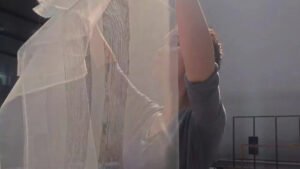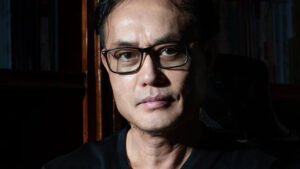
During the Labor Day holiday, I met Feng Boyi, who had recently returned from Changbai Mountain, at the 798 ArtDist. As one of the interviewees for the feature “New Voices of Northeast China,” he admitted that he rarely had the opportunity to visit the Northeast. However, his experience of working with northeastern artists who migrated south to Beijing in the 1990s and organizing exhibitions for them has indeed allowed him to gather an observational sample of his own.
Feng Boyi believes that artists of the Northeast are forthright and vigorous in character, yet they harbor a cunning wit within. Bearing the glory of the past, North-easterners inevitably feel a sense of melancholy when recognizing each other in a foreign land. There is also a feeling of desolation embedded in the essence of their works, but this profound collective sentiment has not been able to further reflect in their artistic endeavors across different generations. Despite possessing strong individual energy, most northeastern artists tend to work alone.
Speaking of the recent fuss about the “Northeast Renaissance,” Feng began by questioning: Apart from being the topic of the moment, where should the culture and art of the Northeast stand in contemporary China? What is its effectiveness? This perhaps reminds us once again that there are still gaps in the research and organization of northeastern culture and art, and its connection to the current cultural landscape and political atmosphere demands further exploration.
Yet the Northeast also represents a certain predicament. People always hope to read through Feng’s observations and obtain a fuller picture of the context of a certain phenomenon in contemporary Chinese art, as well as to hear him say some heartfelt words about the present. Our conversation naturally shifted from regional issues to more general existential conditions: Is today’s experience a reflection of yesterday’s Northeast? Is it still possible to pursue art amidst the cracks of constraints and pressures?
Feng suggests that our understanding of the Northeast today parallels our judgment and planning for the future, both equally barren. Although he hesitates to be overly optimistic, the sensitive artists and sentimental, ambitious local workers have led him to believe that “a single spark can start a prairie fire.”
In the face of an increasingly difficult balance of pessimism and positivity, at least when talking to this curator who refuses to lie down and succumb to cynicism, you share with him the tendency to believe from the bottom of your heart that there are still possibilities, and that you can still look forward to a slow, lengthy relaunch in the process. Feng Boyi’s self-narrative is as follows:
1
Since the 1990s, there has been a group of northeastern artists in Beijing known as the “Northeast Tigers.” Much like artists from Hunan were called the “Hunan Army,” and those from Fujian answered to the “Putian Faction,” it’s like a nickname. Although I don’t know much about the Northeast, I have encountered many Northeast artists in Beijing and organized exhibitions for some of them.
North-easterners are forthright and vigorous, with a cunning wit within. This is my intuitive feeling. I believe that the geographical environment plays a huge role in shaping regional characteristics. The further north you go in the Northeast, the colder it gets. With snow covering the ground for most of the year, people can’t farm or work outdoors, so they mostly stay in. Therefore, the artistic creations of North-easterners are solid and down-to-earth, not emphasizing cleverness and sophistication but rather having a sense of making the best of a tough situation and finding joy in self-amusement.
2
Instead of “drifting north,” it is more accurate to say that the northeastern artists in Beijing are “heading south.” Migration and inhabitation are common phenomena among this group of artists. The economic setback of the Northeast makes it difficult to retain people, and local artists find it tough to realize their potential, so they all flock to Beijing and Shanghai. Unlike artists from Shanghai, who always seem full of confidence, artists from the Northeast often carry a sense of loss and tragic feelings when they cross paths outside their hometowns.
3
The art of North-easterners has a general melancholic undertone. In 2014, I curated a group exhibition for a gallery called “Ruins.” Here, the word “ruins” refers to abandoned sites and deserted areas, which are closely related to the social situation in the Northeast after the economic reforms of the 1980s. Today’s Northeast has a gap in both economic and cultural aspects compared with the past. The Northeast used to thrive, with the steel and oil industries supporting China’s economy and the Changchun film studio driving cultural development, but now they have practically all vanished.
In the works of artists like Wang Bing, Zhao Liang, Wang Ningde, and Li Dafang, there is always a sense of desolation mixed with some degree of absurdity and strangeness. But northeastern art also has another trait, which is the humor represented by Wang Xingwei. Wang Xingwei’s works are developed from northeastern folk culture and contain self-deprecation, irony, and a bit of nonsense. To state it in a perhaps inappropriate way, his work visualized Er Ren Zhuan, a traditional Northeast song-and-dance duet, in the same way that the band Second Hand Rose transformed it into rock music. Zhao Benshan combined Er Ren Zhuan with sketches, which became popular for many years, and today many short videos express the unique humor of the Northeast dialect. From an overall perspective, I think they are all related.
4
Contemporary art in the Northeast can be roughly divided into three stages. In the early years, artists such as Shu Qun and Wang Guangyi, who participated in “the ’85 Movement,” proposed the concept of the “Northern Art Group.” Their paintings mainly portrayed the mountains and rivers of the three northeastern provinces, leaning toward grand narratives rather than small emotions and trivial matters. Then came artists like Wang Xingwei, Li Dafang, and later in the 80s, Song Yuanyuan and Qin Qi, who created a style of painting different from that of the academics. There are also some recently active artists from the Northeast who emphasize the relationship between locality and globalization, or the global indigenousness of the Northeast.
Northeastern artists all have strong individual energy, but they tend to work alone and show a bit of individual heroism without forming a collective consciousness and strength. They are relatively loose as a group. I have tried to find similarities and differences among artists of different generations, but perhaps more organization and research are needed.
5
I have heard about the “Northeast Renaissance,” but I am skeptical of this notion. It cannot simply be called a renaissance just because there is literary creation; I think that is somewhat wishful thinking. Of course, there are indeed many people in the art circle who have begun to develop a cultural consciousness, but in a broader scope, northeastern culture and art still cannot keep pace with the current cultural development in China. Where should the culture and art of the Northeast stand in contemporary Chinese culture? What is its effectiveness?
I have always believed that the creation of cultural art does not show results overnight but requires process and opportunities. Building a cultural art archive for Northeast Asia is the same thing. Many people in Guangzhou are already paying attention to Southeast Asia, but no one has done so for Northeast Asia. So establishing a literature archive is a good idea in terms of subjective desire, but it is a long process of laying the foundation. Without three, five, or even ten years, there may be no results at all. Cultural art requires patience, and revival is also a long-term endeavor.
6
Today, our understanding of the Northeast is based on our judgment and planning for the future, which also appears to be barren. How many uplifting pieces of information do we receive every day that make us feel particularly hopeful? Whether it’s the recent social news about the highway, the changes in national policy, or China’s international image, they all make you wonder: How can we be optimistic?
How can we make art amidst the double crushing pressures of economic development and politics? I think there are still possibilities, and we should at least put up a fight. I’m especially against taking it lying down and thinking that since nothing is going to change, you might as well go with the flow. Finding the most practical survival strategy based on the current situation is the most direct and advantageous experience and ability of a curator; there are still bright, talented artists out there who remain sensitive and can take the initiative.
7
The mainstreaming of art circles in Beijing and Shanghai, as well as the dominance of capitalism over the post-90s generation, are all forms of involution in central areas. Many people in society are entering the civil service or other mainstream systems in search of stability, which also means that the space for folk activities is shrinking and our survival is becoming more and more difficult. A good social or artistic ecosystem must provide different chances of survival for different people. Otherwise, if thousands of people are crossing the same bridge, is that really normal for society?
In the so-called non-central areas, there may be even more constraints, but I believe things are up to people. I have curated exhibitions at the Yalu River Art Museum and have seen Ji Dahai’s passion and ambition in building a museum entirely relying on his personal efforts. He has the daring and boldness of a typical North-easterner. In 2020, he invited me to curate a joint exhibition of two foreign artists, Zhao Renhui and Katja Schenker, which is rare in Northeast China. The Yalu River Art Museum combines northeastern artists with the regional characteristics of Dandong, but does not rely solely on local resources. Instead, it hopes to broaden its horizons and follow a more open path.
8
If I were to use a keyword as a metaphor for the current situation of contemporary art in Northeast China, it might be a bit unfair to keep using “Ruins.” I would prefer “Ruins and Birth,” which both laments the devastated ecology of contemporary art in Northeast China and anticipates its rebirth and revival in the long run.
Whether it’s Changbai Mountain or elsewhere, slowly building an institution can counteract the so-called center, mainstream, or even hegemony. I think that is the role that art plays: it broadcasts different voices and generates diverse modes. A single spark can start a prairie fire.


